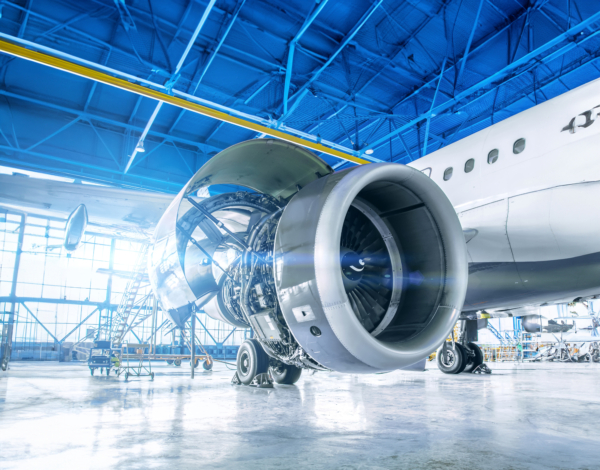The aerospace industry is facing an unprecedented convergence of supply chain pressures.
From rapidly evolving production demands and cost pressures, to globe-spanning instability, and sustainability imperatives, the aerospace supply chain is being pushed to its limits. We’ll explore the challenges facing aerospace supply chains and the factors driving this shift, and look at what companies can and must do to adapt and position themselves for sustainable long-term growth.
Resilience
The aerospace industry is facing turbulence as OEMs recover from the pandemic’s impacts, while fierce competition continues among them.
Supply chain fragilities were laid bare by world events and as production ramps up, these fragilities have shaken confidence in global sourcing. From the lingering effects of COVID-19 lockdowns, to the economic shockwaves of the Russia-Ukraine war, supply chain disruptions are now facing production delays from increased demand. 
According to a Deloitte report1, “the manufacturing industry has seen only a slight recovery in lead times―the delivery times for production materials reached 87 days in August 2023 from its peak of 100 days in July 2022; however, the average lead time has yet to reach the pre-pandemic level. Despite this improvement in 2023, the continuing shortage of raw materials, semiconductors, microelectronics, and other key components or parts will likely remain a key issue for A&D companies in 2024 as production demand increases across the board.”
It’s clear that suppliers to the aerospace industry need to adapt their supply chain best practices that go beyond fire-fighting, and build a truly resilient supply chain.
There is a need for supplier diversification, rather than overreliance on single sources, which can help mitigate risks.
And organisations are facing a dichotomy in their supply chain strategies. On one hand, global supply chains offer cost-effectiveness and competitive advantages through access to diverse markets and suppliers. On the other, there’s a growing trend towards on-shoring or near-shoring. This is to mitigate the risks associated with global supply chain challenges, such as geopolitical tensions, trade disputes, and logistics disruptions discussed.
For the industry to proactively change, assured availability of materials and components is paramount. Which necessitates strategies like on-shoring or near-shoring. Alongside this, bolstering forecasting capabilities while building resilience against future supply chain shocks has become crucial.
The likely solution for many companies will be a blended approach, balancing risk management and availability against cost considerations. This hybrid model allows businesses to use the benefits of global sourcing while maintaining some degree of local or regional production to ensure resilience.
Visibility
And with a lack of resilience, often comes a lack of end-to-end visibility across the supply chain. Opacity, both upstream and downstream, creates significant nervousness and friction among stakeholders at all levels.
69% of businesses currently believe they lack the necessary visibility over their supply chains to protect their reputations2 and in 2023, only 6% of companies reported full visibility on their supply chain3.
Without a clear view of the entire supply chain, companies often resort to stockpiling inventory as a precautionary measure, leading to inefficiencies and increased costs. This lack of visibility makes it difficult to identify bottlenecks, anticipate disruptions, or respond effectively to changes in demand or supply. Consequently, realising operational efficiencies becomes a formidable task, hindering the industry’s ability to optimise its complex supply networks.
The key to addressing these challenges lies in achieving comprehensive visibility across the entire supply chain. Implementing systems and technologies that provide visibility means businesses can gain real-time insights into their supply chains. This enables them to proactively manage risks, optimise operations, and ultimately create more resilient and efficient supply networks that can adapt to changing market conditions and customer demands.
As the aerospace industry continues to grapple with global uncertainties and evolving market demands, the importance of visibility in creating resilient, efficient, and responsive supply chains cannot be overstated.
Understanding the challenges and having a true end-to-end picture of the supply chain is crucial. This comprehensive view, coupled with costed choices, empowers companies to make better-informed decisions about their supply chain strategies.
Ramp up
And as touched on, production ramp up rates are proving extremely challenging. With supply chains needing to scale rapidly to meet heavy demand.
OEMs now face the need to ramp up production rates to meet soaring demand for new aircraft and replacements. However so far, the demand is far outstripping the ability to deliver.
As McKinsey report4, “by December 2023, (global) demand was back to 97 percent of pre-pandemic levels, and it’s expected to grow between 5 and 10 percent annually through 2026. New aircraft orders now total about 15,700. The open-order backlog would take 13 years to address, assuming 2023 delivery rates.”
And, there are worries that tiered suppliers further down the chain lack the capacity and resources to restructure operations and adapt to the new accelerated way of working. This supply-demand mismatch breeds a lack of visibility and trust between OEMs and suppliers.
The potential for suppliers to stumble has compounded issues like demands for unnecessary buffer stock and diminished freedom to shift production as needed. To rectify this, OEMs need to be laser-focused on ensuring their suppliers prioritise quality and adherence to contracted performance metrics.
At the same time, retaining these suppliers is critical even as OEMs seek to diversify their supply base. Striking this balance while bolstering supplier capabilities will be key to maintaining production flow. Tiered suppliers must make investments to increase throughput and modernise, while building closer collaboration with OEMs.
Sustainability
One of the primary issues in the aerospace supply chain is how to keep expensive, serviceable parts in use for longer periods. Extending the lifecycle of these parts not only reduces costs but also minimises waste, contributing to overall sustainability efforts. Additionally, the recycling of rare materials is crucial. These materials are often difficult to source and expensive, so finding ways to reuse them effectively can have a substantial positive impact on both the environment and the industry’s bottom line.
 Another critical area within sustainability is driving reductions in carbon emissions. With Statista reporting5 that the global aerospace industry is close to emitting one billion metric tons of CO2 annually, sustainability within the aerospace industry has become an imperative. Even more so if it is to meet net-zero carbon emissions targets6 by 2050.
Another critical area within sustainability is driving reductions in carbon emissions. With Statista reporting5 that the global aerospace industry is close to emitting one billion metric tons of CO2 annually, sustainability within the aerospace industry has become an imperative. Even more so if it is to meet net-zero carbon emissions targets6 by 2050.
To address sustainability challenges, the industry must prioritise several key areas.
- Reusing scarce materials is a crucial strategy. Ensure that valuable resources are not wasted.
- Regulatory compliance should also not be overlooked. Adhering to environmental regulations not only avoids legal penalties, but also aligns the industry with global sustainability goals.
- Adopting practices that lower greenhouse gas emissions throughout the supply chain. This includes everything from manufacturing processes, to the transportation of materials.
And, the industry must accelerate the shift towards more sustainable forms of energy generation. As Deloitte explained in their 2023 report, the demand for reduced and zero-emission aviation is likely to drive the momentum for more sustainable aviation options like “electric, hybrid, hydrogen, and even solar-powered propulsion technologies” in the coming years.
And finally, cost reduction is essential. Managing expenses allows companies to invest in more sustainable practices without sacrificing profitability.
Cost saving
Alongside cost reduction for sustainability, OEMs and suppliers in the aerospace industry face increasing pressure to reduce manufacturing costs.
And controlling costs is crucial in order to remain competitive. The industry runs on tight profit margins so controlling costs involves optimising every aspect of the supply chain to reduce expenses without compromising quality or performance. And with raw materials subject to price fluctuations, as Markwide Research explain7, “this can pose a real challenge for manufacturers, especially smaller players with limited financial resources.”
Implementing measures such as lean manufacturing techniques and advanced supply chain management can help achieve significant cost savings. Additionally, driving scale and synergies through strategic partnerships, consolidation, and automation can lead to more efficient production processes and reduced overheads.
By integrating advanced automation technologies such as robotics and AI into manufacturing processes, companies can increase efficiency, reduce labour costs, and improve precision. This not only helps in maintaining competitive pricing but also frees up resources that can be reinvested into innovative projects and sustainable practices.
Retaining margins to invest in innovation is another critical imperative. By maintaining healthy profit margins, companies can fund research and development initiatives that drive technological advancements and sustainability efforts. Innovation is key to staying ahead in the aerospace industry, as it enables the development of new materials, processes, and products that meet evolving market demands and regulatory requirements.
Navigating the complex
While the aerospace industry faces a perfect storm of complex challenges – from supply chain fragility, to production ramp-up pressures, and sustainability imperatives alongside rising costs – these obstacles are not insurmountable. By embracing resilience, visibility, agility, and innovation, aerospace companies can pivot to overcome disruptions.
With decades of expertise, Unipart Logistics works with businesses across our seven core capabilities in:
- Planning and supply chain management
- Design, engineering and manufacturing
- Logistics and transportation
- Distributing and wholesaling
- Circular economy services
- Consultancy
- Improvement technologies
Our operations are built on world-class sustainability practices, industry-leading health and safety standards and intelligent digital solutions that help you achieve true end-to-end supply chain transformation.
Unipart logistics is uniquely equipped to provide the visibility, responsiveness, and efficiencies aerospace companies need to navigate today’s challenges and clear the (run)way for long-term growth.
Find out more about how Unipart can help you in the aerospace industry here.
Resources:
- Deloitte – 2024 aerospace and defense industry outlook. 2023
- Fintech – 69% of businesses lack critical visibility over supply chains. 2023
- Zippia – 18 stunning supply chain statistics [2023]: Facts, figures, and trends. 2023
- McKinsey – Addressing continued turbulence: The commercial-aerospace supply chain. 2024
- Statista – Global CO2 emissions from commercial aviation 2004-2022. 2023
- IATA – Net-Zero Carbon Emissions by 2050. 2021
- Markwide Research – Aerospace raw materials market analysis. 2024
